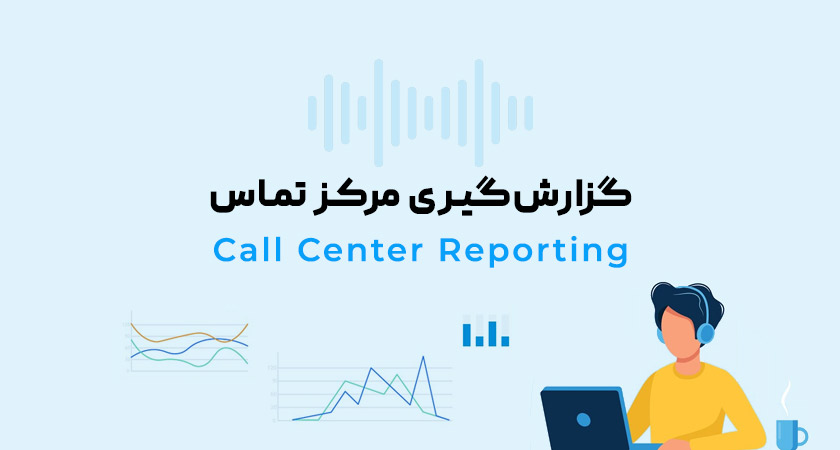Call center reporting plays a critical role in measuring the success of customer service operations.
Recently, call centers have evolved significantly and now include the concept of omnichannel support, allowing customers to interact through phone, email, SMS, web chat, and social media.
Call center reporting refers to a set of processes and methods that enable the collection, analysis, and presentation of data regarding the activities and performance of a call center. This article will define call center reporting and explore its importance and related KPIs.
What is Call Center Reporting?
Call center reporting or call center analytics refers to the process of gathering, analyzing, and reporting statistics related to a call center’s performance and operations. A call center is a place where communication between customers and an organization takes place through phone calls, SMS, online chat, and other communication tools.

This reporting process is crucial because it enables managers and analysts to determine precisely how the call center is performing. It allows for an evaluation of staff performance, customer satisfaction, response times, wait times, call durations, and other performance indicators.
Call center reporting involves collecting data from call center systems, analyzing it quantitatively and qualitatively, and creating strategic and operational reports. These reports may include charts, tables, and various statistics that help managers make the best decisions to improve call center performance. Based on these reports, managers can implement necessary improvements in processes, staff training, and use of appropriate technologies to improve performance and customer satisfaction.
Call Center Reports May Include the Following:
- Number of inbound and outbound calls during a specific time period
- Average response time for calls
- Average customer wait time before response
- Duration of each call
- Customer satisfaction metrics, such as the repeat call rate or customer abandonment rate
- Employee efficiency metrics, like the number of calls answered and average call duration
- Customer conversion rate
- Quality status of calls and customer interactions
Types of Call Center Reports
When it comes to call center operations, there are various types of reports that can provide valuable insights. Below are some types of call center reports we can review:
General Performance Report: Provides a general overview of call center performance, including inbound and outbound call volumes, response times, call durations, and repeat call rates. It gives managers an overall picture of the call center’s operations.
Scheduling and Planning Reports: These include scheduling plans for call center staff, covering shift scheduling, resource allocation, and response times.
Call Quality Reports: Evaluates the quality of interactions between call center staff and customers. This may include quality assessments of calls, audio samples, and recommendations for improving quality.
Staff Performance Reports: Focuses on individual performance metrics for call center staff, including the number of calls answered, customer satisfaction levels, error rates, and overall individual performance.
Customer Satisfaction Reports: Provides insight into customer satisfaction and dissatisfaction with the call center’s services, including customer feedback, complaints, and suggestions.
Analytical and Strategic Reports: These reports analyze call center data, providing reviews, insights, and strategic recommendations to improve call center performance. They aid decision-makers in enhancing processes and performance.
These are just a few examples of call center report types, and depending on each organization’s needs, other types of reports can be designed and utilized.

The Importance of Call Center Reporting
Call center reporting is a key factor in effective call center management and performance. Here’s why it matters:
Accurate and Timely Information: Call center reporting provides accurate, timely information about the call center’s performance, enabling managers and call center teams to stay informed and make optimal decisions when necessary.
Evaluating Service Quality: Reporting allows managers and analysts to assess the quality of services provided by the call center team. By analyzing the received data, they can focus on areas like response times, customer interactions, issue resolution, and customer satisfaction. This qualitative assessment can lead to necessary improvements in call center service delivery.
Optimizing Performance and Resource Management: Call center reports provide useful information regarding resource usage. By analyzing this data, managers can optimize team performance and resource usage. For example, by identifying peak times when workloads and call volumes are highest, staff can be distributed proportionally for optimal resource utilization.
Forecasting Needs and Managing Risks: Reporting provides insights into customer call patterns and needs. By analyzing this information, potential trends and risks in call center performance can be anticipated, allowing for better planning and risk management.
The insights gained from call center reporting help managers make more informed decisions to improve processes and customer satisfaction.

Benefits and Examples of Call Center Reporting KPIs
To measure the performance and quality of a call center, KPIs (Key Performance Indicators) are used. KPIs are metrics for measuring and evaluating the performance of an organization, department, or individual. Below are some benefits and examples of call center reporting KPIs:
Actual Call Statistics
Total Calls Received: Total number of calls received by the call center.
Calls Answered: Number of calls answered by call center agents.
Average Call Duration: Average time spent between the agent and the customer during a call.
Response Time
Average Response Time: Average time it takes for an agent to answer calls.
Customer Wait Time: Average time customers spend waiting in the queue before receiving a response.
Call Completion Rate
Failed Call Rate: Number of calls that couldn’t be answered or were dropped.
Successful Call Rate: Number of calls successfully answered.
Customer Satisfaction
Customer Satisfaction Rate: Percentage of customers expressing satisfaction after a call.
Customer Dissatisfaction Rate: Percentage of customers expressing dissatisfaction after a call.
Abandoned Call Time
Average time a customer waits in the queue without being answered.
Agent Productivity
Calls Answered per Agent: Total calls handled by each agent.
Average Call Duration per Agent: Average call time per agent.
Break Time
Total Break Time: Overall time each agent spends on breaks during the workday.
Benefits of Using Call Center KPI Reporting Include:
- Accurate assessment of call center and agent performance
- Identifying strengths and weaknesses in performance, along with improvement suggestions
- Enhancing efficiency and quality of customer service
- Providing effective data for strategic decision-making in the organization
It is important that KPIs are clearly defined and aligned with organizational goals to be useful and effective. Additionally, KPI-related data should be collected and analyzed regularly to implement necessary improvements in call center performance.
Conclusion
Call center reporting is vital for managing performance and improving the call center. By gathering and analyzing call center data, managers can accurately assess performance and make strategic and tactical decisions to enhance and optimize processes and performance.







